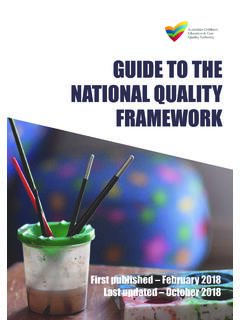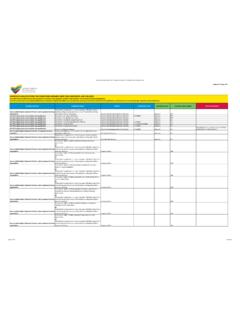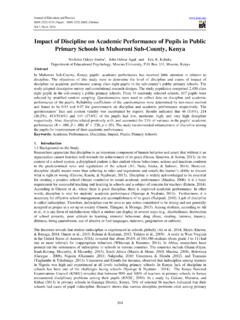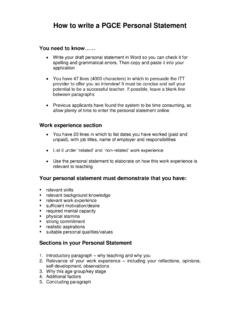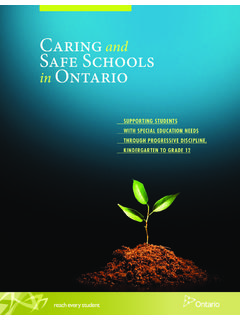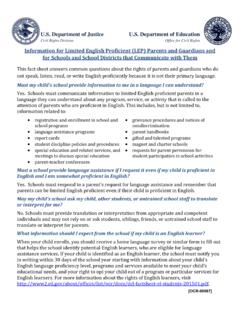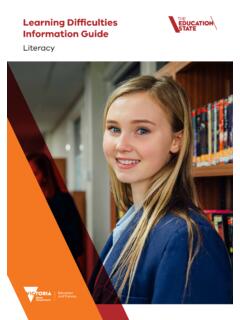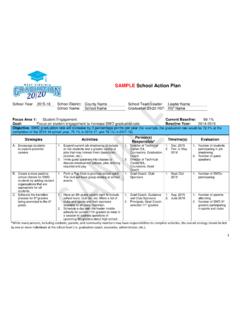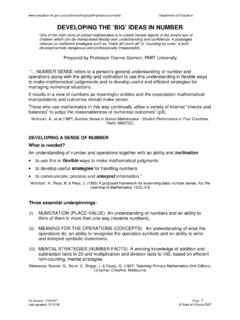Transcription of INAPPROPRIATE DISCIPLINE - ACECQA
1 LINKS TO THE NATIONAL QUALITY STANDARDI ssues of INAPPROPRIATE DISCIPLINE are relevant to Quality Area 5 of the National Quality Standard (NQS), including each of the two standards and four elements. Additionally, issues of INAPPROPRIATE DISCIPLINE have direct links to Quality Area 2 and Quality Area 7, in particular: Standard : Each child s health and physical activity is supported and Each child s wellbeing and comfort is provided for, including appropriate opportunities to meet each child s need for sleep, rest and : Each child is : At all times, reasonable precautions and adequate supervision ensure children are protected from harm and : Governance supports the operation of a quality service. Element : Systems are in place to manage risk and enable the effective management and operation of a quality service.
2 LEGISLATIVE REQUIREMENTS National LawSection 166: Offence to use INAPPROPRIATE 162A: Persons in day-to-day change and nominated supervisors to have child protection training. Section 167: Offence relating to protection of children from harm and 174: Offence to fail to notify certain information to Regulatory Regulations Regulation 12: Meaning of serious incident. Regulation 84: Awareness of child protection 147: Staff members [records]. Regulation 155: Interactions with 156: Relationships in 168: Education and care services must have policies and 175: Prescribed information to be notified to the Regulatory DISCIPLINE | Information sheetINAPPROPRIATE DISCIPLINEI nformation sheet | INAPPROPRIATE disciplineA key objective of the National Quality Framework (NQF) is to ensure the safety, health and wellbeing of children attending education and care services.
3 Corporal punishment and INAPPROPRIATE , or unreasonable, DISCIPLINE are contrary to this objective, and are offences under the National Law. An important aspect of children s belonging, being and becoming involves them learning how their behaviours and actions affect themselves and others. A positive, strengths-based approach to guiding children s behaviour can empower children to regulate their own behaviour and develop the skills needed to interact and negotiate complex social situations and relationships. Information sheet| INAPPROPRIATE disciplineApril 2020 RECOGNISING AND MANAGING INAPPROPRIATE DISCIPLINE DisciplineThe term DISCIPLINE is often associated with punishment and may suggest INAPPROPRIATE , unacceptable and damaging methods of attempting to control children s behaviour.
4 DISCIPLINE is not defined in the Education and Care Services National Law Act 2010 (National Law) or Education and Care Services National Regulations 2011 (National Regulations). However, it can be understood as action taken by adults towards children to stop or change behaviour that is INAPPROPRIATE or not disciplineApproved providers, nominated supervisors, staff members, volunteers and family day care educators must ensure that no child being educated and cared for by the education and care service is subject to any form of corporal punishment, or any DISCIPLINE that is unreasonable or INAPPROPRIATE . During an assessment and rating visit authorised officers may discuss what measures are in place to ensure children at the service are not subject to any form of corporal punishment, or DISCIPLINE that is INAPPROPRIATE .
5 Staff awareness procedures and practices, a clear reporting structure for concerns and a clear and comprehensive policy about staff interactions with children are examples of how compliance may be demonstrated. Examples of INAPPROPRIATE disciplineThe following are some examples of INAPPROPRIATE DISCIPLINE which may constitute a serious breach of the National Law and/or National Regulations and could potentially be considered criminal matters: hitting, pushing, slapping, pinching or biting a child force-feeding a child yelling at or belittling a child humiliating a child physically dragging a child locking children away (or isolating them) depriving a child of food or drink unreasonable restraining of a child (this may include restraint in a high chair) excluding children from events consistently moving children to the office or other space away from the play areas moving children to another room as punishment verbally or physically threatening a examples of INAPPROPRIATE practice are.
6 Negative labelling of child or family criticising a child s actions or behaviours discouraging a child from taking part in activities blaming or shaming a child making fun of or laughing at or about a child using sarcastic or cruel humour with or to a child excessive use of negative language to a child, such as, no stop that! don you APPROPRIATE DISCIPLINE OR BEHAVIOUR GUIDANCEB ehaviour guidanceThe term behaviour guidance is used to indicate positive and effective ways to help children gain understanding and learn skills that will help them to manage their own behaviour. Using appropriate DISCIPLINE , or behaviour guidance, aims to support each child to regulate their own behaviour, respond appropriately to the behaviour of others and communicate effectively to resolve conflicts (NQS Element ).
7 Cool down A cooling down period is a time when a child that is having a difficult moment is encouraged to find a space, near an educator, to cool down and regain self-control. This strategy can be used as an opportunity for educators to support children to regulate their own behaviour, and can be an example of appropriate DISCIPLINE or behaviour guidance. The difference between cool-down time and time out is that an educator stays with the child and reassures and supports them to regulate their emotions during cool-down time. It is viewed as a learning opportunity, not as punishment. Restraint Occasionally, there may be circumstances where a child becomes a risk to themselves or others and may need to be removed from the situation or physically restrained to prevent harm to themselves or others.
8 Children should be physically restrained only in emergency situations. Examples of emergency situations include when a child is: in a clearly unsafe situation, for example, attempting to scale a fence or run onto a road; physically threatening other children or adults; behaving in ways that are destructive to themselves, other people or the TERM DISCIPLINE IS OFTEN ASSOCIATED WITH PUNISHMENT AND MAY SUGGEST INAPPROPRIATE , UNACCEPTABLE AND DAMAGING METHODS OF ATTEMPTING TO CONTROL CHILDREN S BEHAVIOUR. Information sheet | INAPPROPRIATE disciplineApril 2020 These situations may require the supportive holding of children. This means that children are only held long enough to be removed from the situation, and the emergency situation has been addressed or subsided.
9 This approach should only be used when there is an immediate danger of the child being hurt or hurting others and when other strategies to guide the child s behaviour have not worked. If a service has taken a child away from other children to help them cool down or physically restrained the child in any way, the service should inform the child s parent or guardian of the circumstances of the event and record GUIDANCE PLANS AND POLICIES Regulation 168(2)( j) of the National Regulations requires a service to have policies and procedures in relation to interactions with children, including the obligations in regulations 155 and 156. Service policies should outline a clear process for guiding children s behaviour, based on current recognised approaches and with a focus on maintaining the dignity and rights of each child.
10 The National Law and National Regulations do not currently stipulate any requirements for behaviour guidance plans. However, many services use behaviour plans as a reasonable step to prevent harm and hazard for children who have additional needs. Consultation with families and, if appropriate, input and suggestions from other professionals and support agencies should be sought when developing individual behaviour guidance plans for children. Advice may also need to be sought from an appropriate medical professional as to the appropriateness of the guidance. INTERACTIONS WITH CHILDREN Regulation 155 of the National Regulations requires approved providers to take reasonable steps to ensure that their education and care service encourages children to express themselves and their opinions, allows them to undertake experiences that develop self-reliance and self-esteem, maintains their dignity and rights, gives each child positive guidance and encouragement towards acceptable behaviour, and has regard to children s family and cultural values, age.



